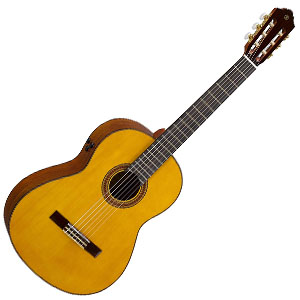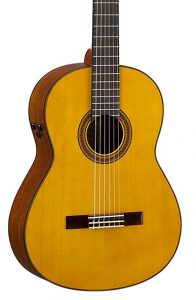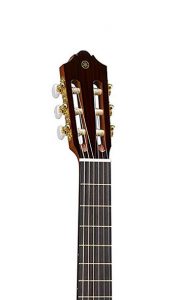- Home
- Instruments
- Gear
- Recording
- Lessons
- Reviews
- Blog


| Body And Neck: |  |
| Hardware: |  |
| Sound: |  |
| Value: |  |
Yamaha is a name that needs no introduction, with a long tradition of manufacturing quality guitars – from budget models to high-end performance workhorses. With the CG-TA – a member of Yamaha’s TransAcoustic collection – they have created a solid nylon-stringed electro-acoustic that has become an impressive entry into the under $1,000 classical guitar market. Let’s take an in-depth look!

A solid Engelmann spruce top combined with ovangkol back and sides rounds out the traditional classical guitar-shaped body of the CG-TA. Spruce is a fairly common tonewood for tops, but ovangkol is a little more exotic. Ultimately, it’s a great choice as a sustainable option for rosewood, and it offers a full midrange. The construction and build quality are top-notch, as to be expected with most guitars with the Yamaha nameplate.
The neck is made from nato – a cost-effective substitute for regular mahogany that offers the same visual appeal and many of the same tonal characteristics. In fact, it is sometimes referred to as ‘Eastern mahogany’. Finally, a true rosewood fingerboard with 19 well-dressed frets adds to the warm tone and smooth playability.

The most unique feature of the CG-TA is the presence of two onboard effects that are often used to sweeten up the sound of an acoustic guitar – chorus and reverb. In fact, there are two types of reverb that can be used – room or hall.
That in and of itself is innovative, but what makes it more impressive is how the effects are produced. Instead of simple digital modulation, the CG-TA uses a custom-designed System 70 TransAcoustic actuator that is mounted to the underside of the top. This actuator takes the vibrations produced when playing and vibrates in response, creating the effects. They can be level-controlled via two knobs on the top bout, along with a traditional volume control. A bonus is that you can get these effects even when playing unplugged!
However, despite these wonderful effects, there are no EQ controls or onboard tuner; if we could improve any aspect of the system, we would include these in a heartbeat. Topping off the electronics end of things, the Yamaha SRT piezo under-saddle transducer is a solid choice.
The tuners are die-cast with a gold finish and pearloid buttons – they are exceptionally functional and are a great visual addition to the gloss natural finish.
While the main feature of the CG-TA is the onboard effects options, it sounds doggone good all by itself. The base tone without the effects is warm, but has a ‘snap’ to it along with a midrange that has some pretty good punch.
Do yourself a favor – take that good base tone and add some of the chorus and reverb. Trust us, if you’ve never used these types of effects on an acoustic guitar before you may be amazed at how rich and full it will sound. It can sound borderline ‘12 string-ish’ if used tastefully.
Of course, you may want to avoid too much – you don’t want to sound like a throwback from the 1980’s! (well, maybe you do… but who are we to say anything?!).
Take away the electronics and the Yamaha CG-TA is still a great choice for a quality classical nylon-string guitar, boasting solid construction with well-selected materials. However, the addition of the innovative System 70 TransAcoustic effects takes it to another level and makes it worthy of your time, especially if you enjoy experimenting.
For more info about the Yamaha CG-TA, click here.
For more of the best classical guitars under $1000, click here.

Reader Interactions